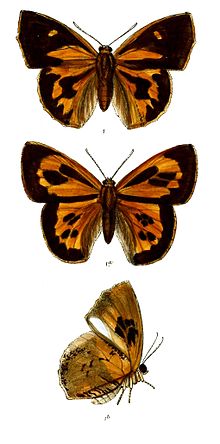Liphyra brassolis
| Moth butterfly | |
|---|---|
 |
|
| Male (top), female and male underside | |
| Scientific classification | |
| Kingdom: | Animalia |
| Phylum: | Arthropoda |
| Class: | Insecta |
| Order: | Lepidoptera |
| Family: | Lycaenidae |
| Genus: | Liphyra |
| Species: | L. brassolis |
| Binomial name | |
|
Liphyra brassolis Westwood 1864 |
|
Liphyra brassolis, the moth butterfly, is a butterfly found in South Asia, Southeast Asia and Australia that belongs to the lycaenid family. The larvae are predatory and feed on ant larvae. This is one of the largest species of lycaenid butterflies. Several disjunct populations across its wide distribution range are considered as subspecies. Never a common butterfly, specimens of this species are highly prized by collectors.
Forewing: costa arched; apex subacute; termen convex; tornus rounded; dorsum sinuate, ciliated, about three-fourths the length of the costa; cell about half the length of the wing; vein 6 out of 7 beyond apex of cell, upper discocellular therefore absent, middle and lower discocellulars subequal, vertical; vein 7 ends on termen well below apex of wing; vein 8 out of 7, from apical half, ends on costa before apex of wing; vein 9 out of 7 from just before middle; veins 10 and 11 free; vein 12 terminates well beyond end of cell on costa.
Hindwing: irregularly pear shaped; costa slightly but widely angulated near base, then straight to apex; termen strongly rounded, tornus well marked, produced into a lobe; dorsum long, slightly convex; cell about half length of wing; middle discocellular short, concave, lower twice length of middle, strongly oblique; vein la very short, ends before middle of dorsum: vein 3 from well before lower apex of cell; vein 7 at base much closer to apex of cell than to base of wing; vein 8 very slightly arched near base, then straight to apex of wing. Antennae about half length of forewing, no distinct club but gradually increasing to apex; palpi porrect (forward pointing), gradually tapering to apex, third joint of moderate length, as thick at base as apex of second joint; eyes naked; body heavy and robust, reminding one in its stoutness of the body of Charaxes.
Liphyra brassolis grows in the nests of ants, especially of tree ants (Oecophylla smaragdina and other species). The caterpillar has tiny antennae-like structures whose function is not known. The adult butterfly at emergence is covered in grey powdery scales which protect it from the ants. Eggs are laid singly or in groups of about six, on the underside of branches of a tree with ants' nest. The eggs are tiny pale green cylinders of 1 mm height.
The species occurs from India to the Philippines, including the tropical coast of Western Australia, the Northern Territory and Queensland.
...
Wikipedia
